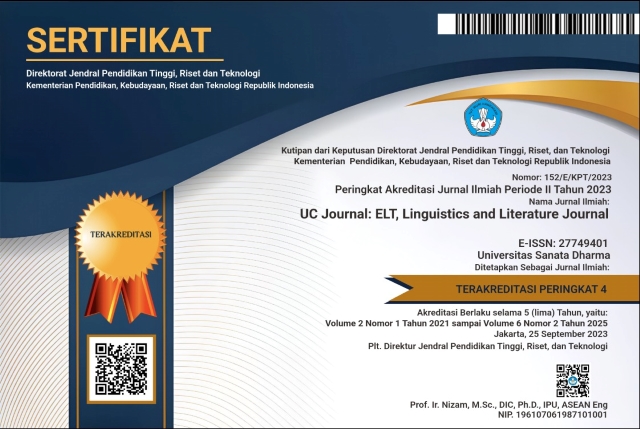SEXIST LANGUAGE SHOWING GENDER STEREOTYPES AS DEPICTED IN EFL TEXTBOOKS
(1) Sanata Dharma University
(2) Sanata Dharma University
(*) Corresponding Author
Abstract
One of the most prominent ways to shape children and adolescents’ mindset is through learning formally at school. EFL textbooks have an important role for students to learn English, but they will also unconsciously learn about gender stereotypes. These gender stereotypes include the belief that women’s role is limited to being a housewife, a good mother to her children, and an obedient woman for her husband. For men, their role is more to the wider part of society, which includes being a breadwinner and more successful in career. The object of this study is BSE English textbooks from grade X-XII. This paper will analyse sexist languages shown in the EFL textbooks using Mills (1995) theory and gender stereotypes using Arliss’ (1991) theory. This research is considered as descriptive qualitative research. The result shows that there are three types of sexist languages: fragmentation, presupposition and inference, and generic nouns. The second research formulation indicates that there are three gender stereotypes, namely stereotypes on traits, roles, and behavior.
Keywords
Full Text:
PDFReferences
Bashir, M. (2017). Bahasa Inggris untuk SMA/MA/SMK/MAK Kelas XI. (2nd ed.). Jakarta: Kemendikbud
Bearman, S., Korobov, N., & Thorne, A. (2009). The fabric of internalized sexism. Journal of Integrated Social Sciences, 10-47.
Biddle, M. (2018, August 09). Men are still more likely than women to be perceived as leaders, study finds. Retrieved May 28, 2021, from http://www.buffalo.edu/ubnow/stories/2018/08/badura-gender-leadership.html
Burton, S. H. (1982). Mastering English language. Basingstoke: Palgrave.
Doyle, M. (1998). Introduction to the A-Z of non-sexist language. In D. Cameron (Ed.), The feminist critique of language: A reader (pp. 149-154). London: Routledge.
Gilbert, S. M., & Gubar, S. (2000). The Madwoman in the Attic: The Woman Writer and the Nineteenth-Century Literary Imagination. Yale University Press.
JubileeProject. (2020, September 25). 6 actors vs 1 fake actor | odd man out. Retrieved May 16, 2021, from https://www.youtube.com/watch?v=h4uA605ryD0
Kappeler, S. (1986). The pornography of representation. Oxford: Polity Press.
Kite, M. E. (2001). Gender stereotypes. In 1376492148 1005902707 J. Worell (Ed.), Encyclopedia of Women and Gender (Vol. 1, p. 563). Academic Press.
Lakoff, R. (1973). Language and woman’s place. Language in Society, 2(1), 45-80.
Markham, I. (2014, April 02). Why do women like to shop more than men? Stereotype or not, researchers have their theories. Retrieved May 28, 2021, from https://www.bustle.com/articles/19853-why-do-women-like-to-shop-more-than-men-stereotype-or-not-researchers-have-their-theories
Mills, S. (1995). Feminist stylistics. London: Routledge.
Nassaji, H. (2015). Qualitative and descriptive research: Data type versus data analysis. Language Teaching Research, 19(2), 129-132. doi:10.1177/1362168815572747
Otlowski, M. (2003). Ethnic diversity and gender bias in EFL textbooks. Asian EFL Journal, (5)2. Retrieved May 8, 2021 from https://www.asian-efl-journal.com/main-editions-new/ethnic-diversity-and-gender-bias-in-efl-textbooks/
The odd one out. (n.d.). In Cambridge Dictionary. Retrieved from https://dictionary.cambridge.org/dictionary/english/odd-one-out
Pattalung, P. N. (2008). An analysis of sexist language in ESL textbooks by Thai authors used in Thailand (Doctoral dissertation). Texas: University of North Texas.
Pérez-Sabater, C. (2015). Research on sexist language in efl literature: Towards a non-sexist approach. Porta Linguarum Revista Interuniversitaria De Didáctica De Las Lenguas Extranjeras, 187-203. doi:10.30827/digibug.53766
Pilcher, J., & Whelehan, I. (2004). Fifty key concepts in gender studies. London: Sage Pubs.
Schaefer, R. T. (2018). Sociology in modules. New York, NY: McGraw-Hill Education.
Shehan, C. L. (2018). Gale researcher guide for: The continuing significance of gender. Farmington Hills, MI: Gale.
Spender, D. (1980). Man made language. London: Pandora.
Wardhaugh, R. (2005). An introduction to sociolinguistics. Chichester, West Sussex:Wiley-Blackwell.
Widiati, U., Rohmah, Z., & Furaidah. (2017). Bahasa Inggris untuk SMA/MA/SMK/MAK kelas X. (3rd ed.). Jakarta: Kemendikbud.
Yenni. (2013). Gender stereotyping shown by sexist language in Phyllida Lloyd's The Iron Lady (Undergraduate’s thesis). Sanata Dharma University. Retrieved from http://repository.usd.ac.id/id/eprint/4985
Young-Eisendrath, P. (n.d.). Ladies, love to shop? I know why! Retrieved May 28, 2021, from https://www.psychologytoday.com/us/blog/living-love/201112/ladies-love-shop-i-know-why
DOI: https://doi.org/10.24071/uc.v2i2.3896
Refbacks
- There are currently no refbacks.
Copyright (c) 2021 Noviantika Saraswati, Rebecca Sarah Ayu

This work is licensed under a Creative Commons Attribution-ShareAlike 4.0 International License.
UC Journal is indexed in:
UC Journal Sinta 4 Certificate (S4 = Level 4)
We would like to inform you that UC Journal: ELT, Linguistics and Literature Journal, or UC Journal has been nationally accredited Sinta 4 by the Ministry of Education, Culture, Research and Technology of the Republic of Indonesia based on the decree No. Surat Keputusan 152/E/KPT/2023. Validity for 5 years: Vol 2 No 1, 2021 till Vol 6 No 2, 2025
DOI: https://doi.org/10.24071/uc
e-ISSN (validity starting Vol 1, No 2, November 2020): 2774-9401

This work is licensed under CC BY-SA.
Creative Commons Attribution-ShareAlike 4.0 International License
 UC Journal: ELT, Linguistics and Literature Journal, a scientific peer-reviewed journal, was established in 20 May 2020 and is published twice a year, namely in May and November, by the English Language Education Study Programme (S1/Sarjana PBI) in collaboration with the English Education Master's Programme (S2/Magister PBI) of Sanata Dharma University, Yogyakarta, Indonesia.
UC Journal: ELT, Linguistics and Literature Journal, a scientific peer-reviewed journal, was established in 20 May 2020 and is published twice a year, namely in May and November, by the English Language Education Study Programme (S1/Sarjana PBI) in collaboration with the English Education Master's Programme (S2/Magister PBI) of Sanata Dharma University, Yogyakarta, Indonesia.














